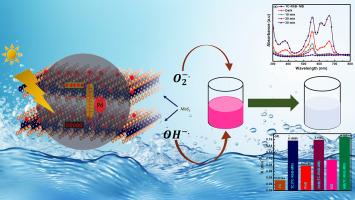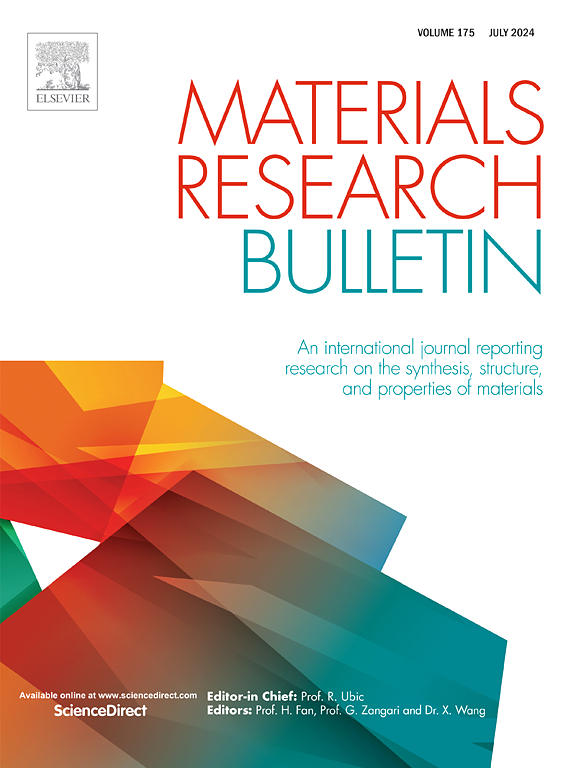Unravelling charge carrier dynamics for enhancement of photocatalytic performance in Pd/MoS2 nanocomposites for water remediation of real-world pollutants
IF 5.3
3区 材料科学
Q2 MATERIALS SCIENCE, MULTIDISCIPLINARY
引用次数: 0
Abstract
In this study, Pd/MoS2 nanocomposites were successfully synthesized incorporating Pd nanoparticles into three-dimensional (3D) flower-like MoS2 nanostructures. The controlled introduction of Pd was aimed to optimize the photocatalytic performance of the resulting nanocomposites, which exhibited exceptional efficiency in degrading various organic pollutants and antibiotic tetracycline (TC) under simulated solar light irradiation. The nanocomposites with an optimized Pd concentration of 2.5 % demonstrated outstanding photocatalytic efficiency, achieving the degradation of Rhodamine B (RhB), Methylene blue (MB), TC by 98 %, 98 %, and 96 %, respectively, with specific interval of 40, 30 and 60 min. The reaction rate constant of the Pd/MoS2 nanocomposites was measured to be 0.7798 min−1 using pseudo first-order rate kinetics. The value is about 19 times higher than that of pure MoS2 (0.00414 min−1) for degradation of RhB. The improved photocatalytic performance of these nanocomposites can be attributed to several factors. Firstly, the incorporation of Pd nanoparticles substantially enhanced their light absorption capabilities, leading to an overall increase in photocatalytic efficiency. Moreover, the presence of Pd contributed to a large surface area, further enhancing the nanocomposite's photocatalytic potential. Importantly, the formation of a built-in electric field at Pd/MoS2 interface facilitated the efficient separation of the electron-hole pairs, extending the life time of these photoinduced charge carriers. This study offers valuable insights into development of MoS2-based photocatalyst, which hold significant promise for addressing water pollution challenges and making substantial contributions to the field of water purification and environmental remediation.

揭示电荷载流子动力学,提高 Pd/MoS2 纳米复合材料的光催化性能,用于现实世界污染物的水处理
本研究成功合成了钯/MoS2 纳米复合材料,在三维(3D)花朵状 MoS2 纳米结构中加入了钯纳米颗粒。在模拟太阳光照射下,这些纳米复合材料在降解各种有机污染物和抗生素四环素(TC)方面表现出卓越的效率。优化钯浓度为 2.5 % 的纳米复合材料具有出色的光催化效率,在 40、30 和 60 分钟的特定时间间隔内,对罗丹明 B (RhB)、亚甲蓝 (MB) 和四环素 (TC) 的降解率分别为 98 %、98 % 和 96 %。利用伪一阶速率动力学测得 Pd/MoS2 纳米复合材料的反应速率常数为 0.7798 min-1。在降解 RhB 时,该值比纯 MoS2(0.00414 min-1)高出约 19 倍。这些纳米复合材料光催化性能的提高可归因于几个因素。首先,Pd 纳米颗粒的加入大大增强了它们的光吸收能力,从而提高了光催化效率。此外,钯的存在有助于形成大的表面积,进一步提高纳米复合材料的光催化潜力。重要的是,Pd/MoS2 界面形成的内置电场促进了电子-空穴对的有效分离,延长了这些光诱导电荷载流子的寿命。这项研究为开发基于 MoS2 的光催化剂提供了宝贵的见解,这种催化剂在应对水污染挑战方面前景广阔,可为水净化和环境修复领域做出重大贡献。
本文章由计算机程序翻译,如有差异,请以英文原文为准。
求助全文
约1分钟内获得全文
求助全文
来源期刊

Materials Research Bulletin
工程技术-材料科学:综合
CiteScore
9.80
自引率
5.60%
发文量
372
审稿时长
42 days
期刊介绍:
Materials Research Bulletin is an international journal reporting high-impact research on processing-structure-property relationships in functional materials and nanomaterials with interesting electronic, magnetic, optical, thermal, mechanical or catalytic properties. Papers purely on thermodynamics or theoretical calculations (e.g., density functional theory) do not fall within the scope of the journal unless they also demonstrate a clear link to physical properties. Topics covered include functional materials (e.g., dielectrics, pyroelectrics, piezoelectrics, ferroelectrics, relaxors, thermoelectrics, etc.); electrochemistry and solid-state ionics (e.g., photovoltaics, batteries, sensors, and fuel cells); nanomaterials, graphene, and nanocomposites; luminescence and photocatalysis; crystal-structure and defect-structure analysis; novel electronics; non-crystalline solids; flexible electronics; protein-material interactions; and polymeric ion-exchange membranes.
 求助内容:
求助内容: 应助结果提醒方式:
应助结果提醒方式:


